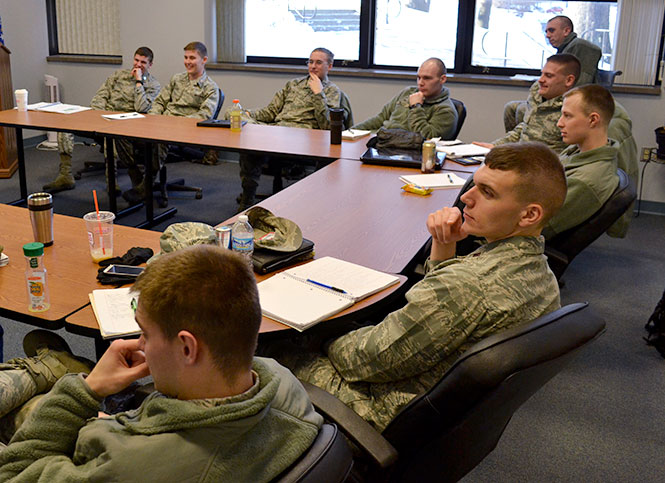New Air Force commander assigned to Kent State ROTC
A group of Air Force ROTC cadets learn about various Air Force plane models, Thursday, Jan. 30, 2014. The class was lead by newest commander Lt. Col. Daniel Finkelstein in Terrace Hall.
February 3, 2014
The commander in charge of the Air Force ROTC program is reassigned to a different position every three to four years. On June 28, 2013, Lt. Col. Daniel Finkelstein officially took over as the new commander of the Air Force ROTC program and the head of the Department of Aerospace Science.
Finkelstein said he is enthusiastic about his new position.
“I want to be here,” he said. “I really care about the future that these young people have.”
Being a Commander, Finkelstein said, is special because it is the pinnacle of what an air force officer can do. He said that with the help of his great staff, there is no question that the Air Force ROTC program will be successful.
Before his time at Kent, Finkelstein was stationed at Barksdale Air Force Base in Shreveport, Louisiana, where he was the technical director for the Air Force Global Strike Command. This command was responsible for the nuclear operations for aircraft, missiles and equipment. Prior to that, Finkelstein earned a doctorate in Mathematics from the University of Virginia, taught at the Air Force Academy in Colorado Springs and flew fighter air crafts on many flying assignments.
As the new commander of the Air Force ROTC program at Kent State, Finkelstein said he wants to make sure every student that leaves the ROTC detachment is a top-quality cadet.
“ROTC is designed to train these cadets to go be officers,” Finkelstein said. “So at the end, we commission them, and that’s where they go from being a cadet to an officer. And every time we have one of those walk across stage its pretty simple: I want to be proud of what it is we put out.”
Finkelstein said there are not too many changes that are going to be made within the ROTC program. However, he does plan on pushing the program to really try to replicate the real Air Force.
“I want the ROTC program to mirror the things we do on active duty as much as possible,” Finkelstein said. “We want to change the culture here so when you are in ROTC, it is going to look as much like the real air force as it can.”
Finkelstein said they even restructured the cadet organization to look more like an actual air force wing.
Many cadets seem to be responding positively to the new commander.
Cynthia Benson is a senior justice studies major and Air Force ROTC cadet and holds the position of the Cadet Wing Commander. She said the biggest difference with the change in command is the new level of standard and involvement.
“I’ve seen a whole different change in the cadet wing,” Benson said. “People volunteering for stuff, stepping up, our camaraderie and morale is so much higher than its ever been.”
Andrew Altizer, senior computer science major and a member of the Air Force ROTC program, was enlisted in the Air Force prior to his involvement with ROTC. He explained how Finkelstein is one of the friendliest commanders he has met.
“He’s more personable than a lot of people I’ve met. He knows every cadet; he knows a lot of our situations and what were going through,” Altizer said. “He’s there to help us out if we need help.”
“I’m going to retire in about five or six years,” Finkelstein said. “So I want to make sure to leave my Air Force in good hands.”
Contact Mary Booth at [email protected].

























